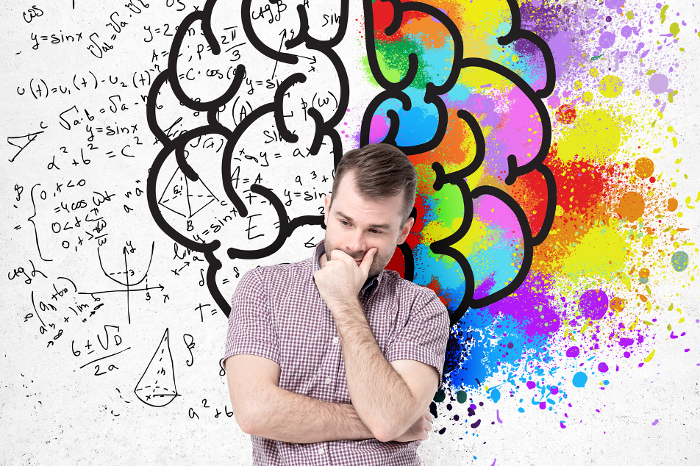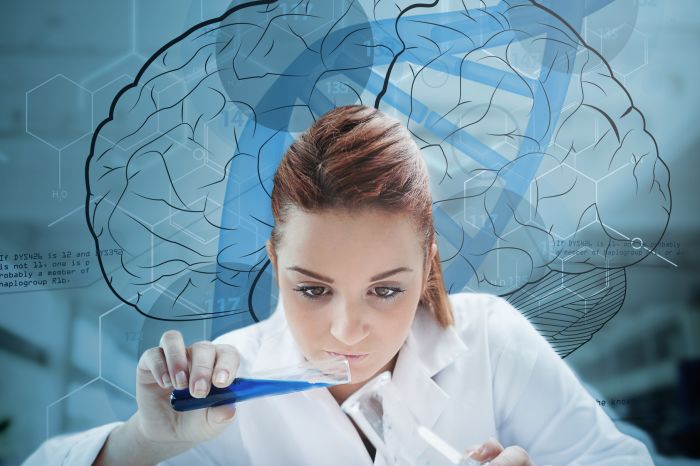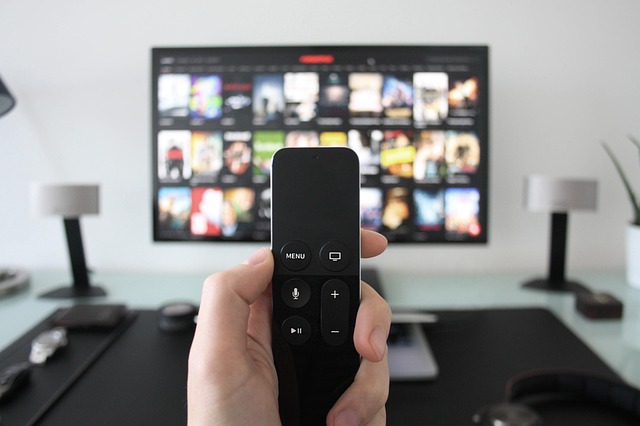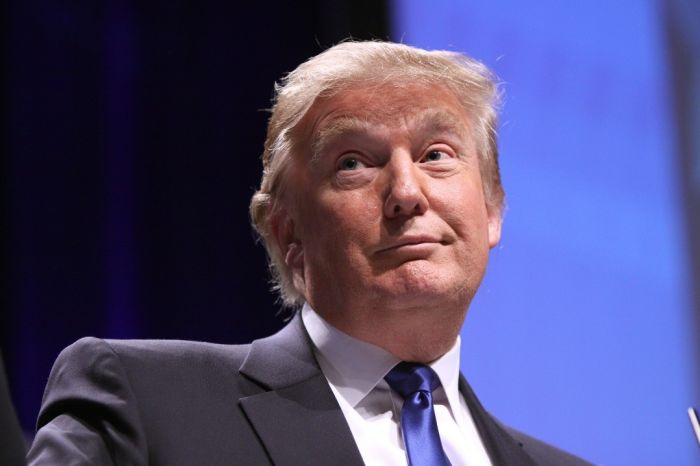
This post was originally published just before the 2016 Presidential election…
Although the election has passed, there are still many things to be learned from the Trump campaign about building brand loyalty.
Say what you will about Donald Trump, the man knows how to stir up big feelings in people.
The remarkable (some may say infuriating) thing is, despite a stream of gaffs and incendiary comments that would demolish other political candidate’s campaigns, Trump’s supporters still see him as their champion.
He has identified his niche market and focuses on them – almost exclusively. And that focus has rewarded him with steadfast support.
What’s his secret? Emotional marketing.
This drives superb branding.
There’s no doubt The Donald loves branding. He even named his bottled water brand “Trump Ice.”

[ Source: Juliana Lopes – Trump Ice, CC BY-SA 2.0 ]
The good news is you don’t need to have your own personally branded bottled water, hotels, golf courses or wine. I’m going to show you how Donald Trump, and other top brands, build almost unshakable brand loyalty…and the three steps you can follow to do the same thing.
Trump sticks to Rule Number One in brand creation:
Emotion Trumps Reason.
Emotion inspires deep brand loyalty. It’s so strong that die-hard supporters are willing to follow a political candidate even after he’s clashed with military families, former POWs, and made comments and gaffes that would have ended any other presidential candidate’s campaign.
But…why?
And more importantly:
How can we tap into the power of emotions to build brand???
I’m going to give you the whys and the hows of emotion-based branding. And I promise I’ll keep politics out of it.
Let’s take a deeper look at what’s going on inside the heads of Trump’s supporters.
Making Decisions is about Feeling, not Thinking
When most people think of how we make important decisions, we tend to imagine a rational activity.
It doesn’t matter if you’re choosing shaving cream, or a Presidential candidate. We gather facts. We think through the costs and the benefits. We look at the arguments about the topic and consider the pros and cons. Only once we have all this ‘data,’ do we make a decision.
AS IF.
There’s more to it than that. Research shows that decision making is often a nonconscious activity.
Nonconscious. As in: I do not consciously think about breathing, walking, blinking, swallowing. All these are activities I don’t give a single conscious thought.
An example of this kind of decision making was demonstrated in 2008. Neuroscience and cognitive scientists teamed up to track a simple decision:
Did test participants want to press a button with their left or right hand?
Researchers watched brain activity, and were able to predict which hand someone would use to press the button. They knew this 7 seconds before the participants reported consciously making their choice.
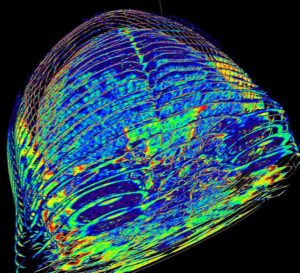
[ Source: Dale Mahalko – Own work, CC BY-SA 3.0 ]
In short: before I’ve consciously/rationally reached a decision, I’ve already made the decision.
This is just one study indicating that we don’t simply make decisions through a step-by-step logical process. Brain science research demonstrates that people make decisions based on habit, experience, and emotions.
Emotions Drive Decisions
A few years ago, neuroscientist Antonio Damasio made an amazing discovery. He studied people with brain damage that inhibited their ability to feel emotions.
The brain trauma patients had something else in common, too: they couldn’t make decisions.
They could tell you what they should, logically, do in a situation.
But making even a simple decision, like what day to schedule a meeting, was difficult. Test subjects were confronted with a decision where both options have pros and cons. Something as simple as: should I eat chicken or turkey for lunch?

[ Source: Andrew Currie – Decisions, CC BY-SA 2.0 ]
The emotionally impaired test subjects couldn’t reach a decision.
One person spent 20 minutes simply trying to decide whether to set an appointment for a Wednesday or Thursday.
“The reason why they can’t choose is that they haven’t got this sort of lift that comes from emotion. It is emotion that allows you to mark things as good, bad or indifferent…They cannot conjure up for a given situation an emotional state that would decide them in one direction or another.”
– Antonio Damasio
Negative emotional experiences serve as an alarm signal. Positive emotional experiences serve as an encouragement. Together they create a nonconscious frame of reference that directly impacts our decision making.
It’s why ads about beer feature beaches or get-togethers with friends. It shows people a picture of what they want to experience. But more important: it echoes experiences they have already had, and enjoyed. This creates a positive disposition and emotional relationship to the brand.
Why? Because, science.
Remember that old line about how ‘People Buy on Emotion and Rationalize With Logic?’ Well, research totally supports that.
This also gives insight into why Trump’s steadfast supporters stand by him despite ‘rational’ (or ‘intellectual’) criticisms that would invalidate other candidates.
They stand by him despite arguments that Trump has no:
- political experience
- policies
- professional campaign
- ground game
and according to Google’s Instant Search Recommendations, he has “no chill.”
All this “rational” data would be poison to any other ‘typical’ politician. Donald Trump’s supporters stand firm. Why?
He speaks directly to their emotions.
That’s what Trump does.
And Disney.
And Coke.
And Apple.
How they do it is another story. Literally.
Storytelling: The Ultimate Brain Hack
Once upon a time, a neuroscientist named Paul Zak conducted a study. He invited participants to watch a short animated video. In it a father told the story of his three-year-old son, Ben, who was dying of cancer.
Some of the participants were moved to tears. Most found the story to be heartbreaking and it made them want to do something to help. After watching the story, nearly all of the participants donated a portion of their earnings from the experiment to a childhood cancer charity.
But the point of the study wasn’t fundraising: it was to see how stories change the human brain.
Stories Change Your Brain
The participants also watched another video: Ben at the zoo with no narrative context. Scientists observed that their oxytocin levels were higher when they watched the video talking about how Ben was dying of cancer. It was only when oxytocin was triggered that participants chose to donate to the cancer fund.
Oxytocin is one of the messengers that travels from the rational mind to the emotional mind. It’s the hormone that triggers emotions like love, trust, and empathy. It makes it possible to walk in someone else’s shoes, or to see oneself in an imagined situation.

[ Source: Pierre Phaneuf – Empathy, CC BY-SA 2.0 ]
When we listen to a story about someone else, oxytocin is the reason we have an emotional reaction to what happens to them.
Participants listened to Ben’s father talk about how hard it was to watch his son play, knowing that it might be the last time he sees him. But he struggles to stay positive for Ben’s sake because he wants to give his son a good quality of life.
People can relate to that. They feel his sadness, they empathize with his struggle, and most importantly, they want to do anything they can to help his child.
So they donate to a charity that will hopefully save families like Ben’s from the heartbreak they’ve just experienced.
Stories don’t just get oxytocin flowing: a whole fireworks show of neurons and emotion-causing hormones light up when we listen to a narrative.
We Live the Stories We Hear
In a separate study, scientists observed that when we listen to language that evokes the senses, our brains react as though we are actually experiencing what the language is describing.
So when we hear “he pounded his fists against the cold concrete wall,” we feel our own hands clench into fists, we feel the chilliness and hardness of the wall.
It’s the same reason we grimace or startle when we see an actor getting physically hurt in a movie. Our rational mind knows it’s fake, but the visual narrative triggers empathy for the character’s pain. Our reptile brain reacts to the perception of a physical threat by sending a message: “bear your teeth” and “tense your muscles.”
The Story Trump Tells And Why It Sells
Which brings me to the narrative Donald Trump has carefully crafted and to which his millions of supporters relate: the story of America Under Threat.
The structure of Trump’s story follows a classic sales letter formula: Problem-Agitation-Solution.
Let me walk you through it:
In all Trump’s speeches, including the one he gave at the Republican National Convention, the common theme is the notion that America was once a powerful nation but has been weakened by job loss, an increase in crime, and global terrorism. On top of all this – the system is corrupt and rigged against you. These are topics he knows are guaranteed to grab his audience’s attention, and about which they have strong feelings and opinions.
This is “the problem.” His audience already has opinions about the state of the nation – and this part of the sales letter story is all about reflecting their problem. Identifying it, and confirming that it exists. In fact, as with all great sales letters, you have to do more than that.
In classic sales letter fashion, you have to agitate the problem – make it as bad as you possibly can. If you have grass stains in your kid’s jeans, they have to be the kind that nothing manages to take out and now you have to go buy a new pair of jeans and “have you seen how much those cost now?!?” The problem was dirty jeans – but now, well now I have a personal finances issue.
Agitiate.
Once you’ve done this – and only once you’ve done this – can you offer the solution to all these problems.
Let’s look at how Trump’s sales letter story does this:
1) Trump starts with four of his audience’s “problems”:
- job loss,
- an increase in crime,
- global terrorism,
- a ‘broken’ political system.
2) As these are established he goes on to agitate with the story. It’s about a country that doesn’t “have victories” anymore, a country taken advantage of by other countries, a country run by people who have led it into failure.
In his own words: “We don’t have victories anymore. We used to have victories, but we don’t have them.”
Now the problems of the country become larger, more personal problems:
- People coming into this country either illegally or as refuges are taking YOUR jobs
- YOUR neighborhood isn’t safe to walk in without fear of being shot
- Terror is spreading across the globe and YOU are no longer safe from the threat of terrorism
- Worst of all, these are happening because YOUR country doesn’t win anymore.
This is a picture that people can step right into – in fact, it mirrors many fears and thoughts of his audience. Abstract issues and problems are made personal and tangible in a way that the audience can FEEL.
At this point the audience is desperate for relief from these problems. They are right there, in the moment, in pain: “Yes, yes yes!” they say. “This is terrible! But what can be done?”
Once the problem is defined and agitated, the sales letter story goes to the next step: presenting a solution.
3) The sales letter story continues: political corruption and ineffective government policies are to blame for this mess. So there’s no finding help in government. The only possible solution is through an unsullied outsider – someone with no tolerance for dishonesty, politics-as-usual, or weakness.
And Donald Trump is that outsider.
“I alone can fix it.”
His words.
That’s a pretty powerful story, isn’t it?
Let’s examine the elements of Trump’s sales storytelling genius and why they work (Hillary, if you’re out there reading this, pay attention):
First of all, the story of America Under Threat triggers big feelings that appeal to instinctive behavior.
The Emotional Triggers:
- fear
- anger
- powerlessness
These emotions are at the core of our survival mechanisms: when we feel afraid, our brain fires off a shot of glutamate deep into the base of the brain: that’s what makes us freeze or involuntarily jump.
It also signals the hypothalamus and triggers our autonomic nervous system the crank up our heart rate and flood our bodies with adrenaline.
That burst of adrenaline is behind the ‘fight-or-flight’ reaction: when we feel afraid, it gives us the energy to run. When that fear turns to anger, we use that energy to fight.
Not every powerful story has to trigger negative emotions or aggressive actions.
For example, Disney’s story of The Magic Kingdom inspires feelings of hope, wonder, friendship and excitement.

[ Source: Patrick Pelletier- Disney princesses, CC BY-SA 2.0 ]
But in order to achieve a desire for action, you have to create a contrast between the emotions that your protagonist experiences before and after discovering the solution to their problem. Disney protagonists often start out as lonely until they are transported into a world of adventure (hope, wonder, excitement) and make friends.
Trump establishes an emotional contrast with his story, too. He begins a story about a powerless America steeped in fear. Then as he describes his plans as president, he continues to appeal to emotions over facts and figures. Every time he talks about his wall along the border or tighter control over who comes into the country, he transports his supporters’ imaginations into a future full of comfort, power and safety.
Because Trump’s proposals align with many of his supporters’ core values, he’s also appealing to their sense of identity. In a sense, each member of Trump’s audience is seeing him or herself as the hero of his story.
A Relatable Protagonist
In Trump’s story, the main character– or brand protagonist, in marketing-speak, is America. America is characterized as a no-nonsense, hard-working gal or guy who takes no – well, you know. In other words, Trump’s America acts a surrogate for each of his supporters.
Then again, Trump’s America is a very different character than Hillary Clinton’s America in terms of looks, worldview, and core beliefs. And your vote all depends on which America you relate to the most.
An example of a more universally relatable brand protagonist is Coca-Cola’s hippy girl. In the 1970’s during the height of civil unrest, Coke offered a protagonist who just wanted peace, comfort and togetherness.
She wanted to buy the world a Coke, you guys.
Message Consistency
In every bit of content Trump creates, whether it’s a speech or a tweet, his message is consistent:
“Political correctness, weakness, and political corruption have ruined our country. You have every reason to feel angry and fearful and powerless. And I know what to do about it:
I’m going to Make America Great Again.”
An Emotional Solution to an Emotional Problem
“Make America Great Again” is a phrase that offers the opposite of fear, anger, and weakness.
It offers power.
That promise of power is what connects millions of people in our country to the Donald Trump brand.
It’s what gets him through the rough spots: he may say things that are inappropriate for a candidate for President, but everything he says is perfectly in line with his brand.
And he does this step-by-step in a manner that speaks to his audience’s emotional “decision-maker.”
- He bypasses facts and figures and instead connects emotionally.
- He aligns with and associates himself with, his audience’s beliefs.
- He tells stories, and uses a Problem-Agitate-Solution structure to communicate his message, to provide his ‘proof points’ and ultimately lead his audience to the conclusion that what he is selling: President Trump, is the only solution to their problem. The only thing that will make them feel good.
It’s not about Trump’s brand – it’s about how his brand makes his audience feel about themselves. By supporting Trump, his supporters feel powerful.
Because the brands we create are the emotions we sell.
Donald Trump sells power.
Disney sells wonder.
Coke sells comfort.
Apple sells optimism.
What emotion do you want to sell?






